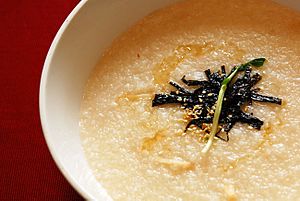Jeonbok-juk facts for kids

Jeonbok-juk made without the abalone's internal organs
|
|
| Type | Juk |
|---|---|
| Place of origin | Korea |
| Serving temperature | warm |
| Main ingredients | Abalone, rice |
| 58 kcal (243 kJ) | |
| Korean name | |
| Hangul |
전복죽
|
|---|---|
| Hanja |
全鰒粥
|
| Revised Romanization | jeonbok-juk |
| McCune–Reischauer | chŏnbok-chuk |
| IPA | [tɕʌn.bok̚.t͈ɕuk̚] |
Jeonbok-juk (Hangul: 전복죽; Hanja: 全鰒粥) or abalone rice porridge is a variety of juk (죽; 粥), or Korean porridge, made with abalone and white rice. Abalone is regarded as a high quality ingredient in Korean cuisine and was often presented as a gift to the king of Korea. The dish is a local specialty of Jeju Island where abalones are commonly harvested. Jeonbokjuk is known as not only a delicacy but also as a nutritional supplement and digestive aid, especially for ill patients or elderly people. Jeonbokjuk can be made with or without the abalone's internal organs. The former type of jeonbokjuk has a green tinge while the latter is more ivory in color.
Preparation and serving
Abalones are first prepared by cleaning with a brush in water, and the flesh is taken out from the flat and middle of the shells with a small kitchen knife. The internal organs are removed separately from the flesh (taking care not to damage them). The flesh is slightly parboiled in a pot of boiling water and then thinly sliced. Rice is soaked in a bowl of water 3 to 4 hours before cooking. The abalone flesh is stir-fried on a pot over a mid-flame with sesame oil, with the soaked rice then added. After stir frying for a while, water is poured into the pot and the dish is cooked at a higher temperature. Constant stirring prevents the ingredients from sticking to the bottom of the pot. After the dish has come to a boil, the heat is lowered and let to simmer. The dish is seasoned with salt or ganjang (Korean soy sauce).
See also
 In Spanish: Jeonbokjuk para niños
In Spanish: Jeonbokjuk para niños


